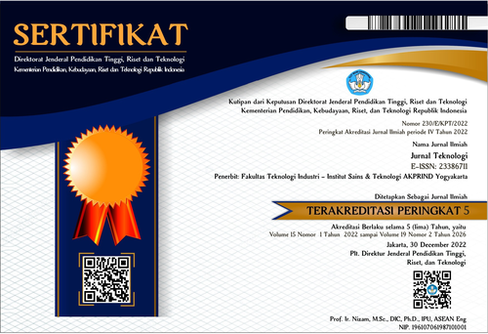Pelacakan Titik Daya Maksimum Algoritma Incremental Conductance pada Photovoltaic Dipasang Paralel dan Seri
DOI:
https://doi.org/10.34151/jurtek.v17i1.4708Keywords:
Conventer, IC Algorithm, MPPT, PVAbstract
Photovoltaic (PV) is an environmentally friendly renewable energy source. Photovoltaic when connected directly to the load, the power delivered to the load is not optimal. Therefore it is important to get maximum power from the PV system to increase efficiency. This study presents an MPPT system using the Incremental Conductance (IC) algorithm to analyze PV systems installed in parallel and installed in series using 3 PVs. This IC algorithm works by monitoring the current gradient to determine the direction of voltage change and providing a change in derivative voltage so that it can determine the speed of delivery. From the results of the study, the average power using 3 PVs installed in series was 95.4% and using 3 PVs installed in parallel was 88.44%. The algorithm (IC) has a faster response in tracking the maximum power point when installed in parallel even though its efficiency is lower. However, current variations when there are changes in solar radiation tend to be constant as long as the temperature conditions are close to stable.
Downloads
References
Abderrahim, T., Abdelwahed, T., & Radouane, M. (2020). Improved strategy of an MPPT based on the sliding mode control for a PV system. International Journal of Electrical and Computer Engineering, 10(3), 3074–3085. https://doi.org/10.11591/ijece.v10i3.pp3074-3085
Abo-Sennah, M. A., El-Dabah, M. A., & Mansour, A. E. B. (2021). Maximum power point tracking techniques for photovoltaic systems: A comparative study. International Journal of Electrical and Computer Engineering, 11(1), 57–73. https://doi.org/10.11591/ijece.v11i1.pp57-73
Ali, M. H. M., Mohamed, M. M. S., Ahmed, N. M., & Zahran, M. B. A. (2022). Comparison between P&O and SSO techniques based MPPT algorithm for photovoltaic systems. International Journal of Electrical and Computer Engineering, 12(1), 32–40. https://doi.org/10.11591/ijece.v12i1.pp32-40
Fathy, A., Atitallah, A. Ben, Yousri, D., Rezk, H., & Al-Dhaifallah, M. (2022). A new implementation of the MPPT based raspberry Pi embedded board for partially shaded photovoltaic system. Energy Reports, 8, 5603–5619. https://doi.org/10.1016/j.egyr.2022.04.035
H. Salman, U., Fleyeh Nawaf, S., & Omar Salih, M. (2022). Studying and analyzing the performance of photovoltaic system by using fuzzy logic controller. Bulletin of Electrical Engineering and Informatics, 11(3), 1687–1695. https://doi.org/10.11591/eei.v11i3.3680
Husain, M. A., Tariq, A., Hameed, S., Arif, M. S. Bin, & Jain, A. (2017). Comparative assessment of maximum power point tracking procedures for photovoltaic systems. Green Energy and Environment, 2(1), 5–17. https://doi.org/10.1016/j.gee.2016.11.001
Loukil, K., Abbes, H., Abid, H., Abid, M., & Toumi, A. (2020). Design and implementation of reconfigurable MPPT fuzzy controller for photovoltaic systems. Ain Shams Engineering Journal, 11(2), 319–328. https://doi.org/10.1016/j.asej.2019.10.002
Matalata, H., Wustha Johar, L., & Eka Yandra, F. (2024). Pelacakan Titik Daya Maksimum Photovoltaic Dc-Dc Boost Converter Dengan Algoritma P&O. Jurnal Teknologi Dan Vokasi, 2(1), 105–115. https://doi.org/10.21063/jtv.2024.2.1.13
Ouremchi, M., El Mouzouade, S., El Khadiri, K., Tahiri, A., & Qjidaa, H. (2022). Integrated energy management converter based on maximum power point tracking for photovoltaic solar system. International Journal of Electrical and Computer Engineering, 12(2), 1211–1222. https://doi.org/10.11591/ijece.v12i2.pp1211-1222
Saidi, A. S., Salah, C. Ben, Errachdi, A., Azeem, M. F., Bhutto, J. K., Thafasal Ijyas, V. P., & Slimene, M. Ben. (2021). A novel approach in stand-alone photovoltaic system using MPPT controllers & NNE. Ain Shams Engineering Journal, 12(2), 1973–1984. https://doi.org/10.1016/j.asej.2021.01.006
Sepannur Bandri, D. (2021). Pengaruh Intensitas Cahaya Matahari Terhadap Tegangan Dan Arus Yang Dihasilkan Panel Surya. Jurnal Teknik Elektro, 10(2), 106–113.
Winarno, T., Palupi, L. N., Pracoyo, A., & Ardhenta, L. (2020). MPPT control of PV array based on PSO and adaptive controller. Telkomnika (Telecommunication Computing Electronics and Control), 18(2), 1113–1121. https://doi.org/10.12928/TELKOMNIKA.v18i2.14845
Downloads
Published
How to Cite
Issue
Section
License
Copyright (c) 2024 Hendi Matalata, Leily Wustha Johar

This work is licensed under a Creative Commons Attribution-ShareAlike 4.0 International License.
Jurnal Teknologi provides immediate open access to its content in order of making research freely available to the public to support a global exchange of knowledge. All articles published in this journal are free for everyone to read and download, under licence CC BY SA.
Benefits of open access for the author, include:
- Free access for all users worldwide.
- Authors retain copyright to their work.
- Increased visibility and readership.
- No spatial constraints.




















